Despite only being David Fincher’s second feature length film, I would state ‘Se7en’ (1995) to be his most definitive film, one that also proved to be his breakthrough feature, and till date, twenty-five years after its release, is recognised as such. Yes, ‘Fight Club’ came out four years later as well, and I deliberately refrained from stating it in that capacity. It sure can be termed Fincher’s most iconic film, but the most definitive Fincher film? That has to be this by a long shot. He has made atleast five excellent thrillers following Se7en, and while some of those got really close, none has been able to topple the relentless suspense, nerve-racking thrill and its sickening, kick in the gut kind of twist ending.
Twenty five years hence, now that we are almost fully acquainted with the plot and the ending, we lead an investigation into understanding the seven sins and their embodiments better, the significance of the twist ending, and how the seventh sin was completed. However, that is kind of the deal with writing about iconic movies. It feels like an exercise in futility because what more can one say about something that already has monuments built to its name? Regardless, that is not going to stop us from trying to shed light on one of the most iconic films of the 90s, and among the best thrillers ever made, wherein Se7en would rank closely among the top ranks. In light of that, rather than taking the conventional route of the entire plot being explained, we attempt to break it down with respect to the seven cardinal sins and how they were committed, narrowing on the MO of one Jon Doe. Read on.
Summary of the Plot

In an unnamed city, detective William Somerset (Morgan Freeman) who is soon set to retire and presumably knows all the rules of the game is paired with hot-headed detective David Mills (Brad Pitt), who has also just moved to the city with his wife. The two are immediately put to a case, the details of which we will list later, but one that points to a possible case of serial killing, and not random, unassuming homicide. As the crimes progress, one for each day, conspiring over a period of seven days, which is also the time left for det. Somerset to serve on the force, the modus operandi of the murders as being related to the seven cardinal sins as listed in the Biblical texts becomes clear.
As the two detectives, vastly different in their worlds and methods, continue their investigation, they learn more about each other’s personal lives and meld into working as partners, trying to get the gist of the bizarre nature of the crime and the sheer brutality of it. Meanwhile, Mills’ wife Tracy is extremely dissatisfied about the couple having moved to a new, unknown city, and feels fearful for their future. As the Mills family and Somerset grow closer, the latter even being invited to have dinner over at the Mills’ place, Tracy confides in Somerset that she was pregnant and felt that the city was not a place to raise a kid, being increasingly put off by the crime and the grim happenings in the city. She is advised by Somerset on this matter who tells him that she should only tell Mills if she plans on having the baby. With this in the background, the murders grow more gruesome, and the two detectives get involved with more personal stakes than they had imagined or asked for.
Following the fifth murder, the killer, John Doe walks in and surrenders, allowing himself to be taken in for his crimes. With the motif now clear, he offers to bring the detectives to the final two victims, upon a certain set of conditions being met. The two reluctantly agree, and drive to a remote location in the desert, where the rest of the devastating finale follows. Interestingly enough, John Doe is usually the name given to a character when his actual name is not to be revealed. In consonance, the grim city where the murders are staged is also never mentioned by name. Could the writer be telling us something? Just something to think about.
The Ending, Explained
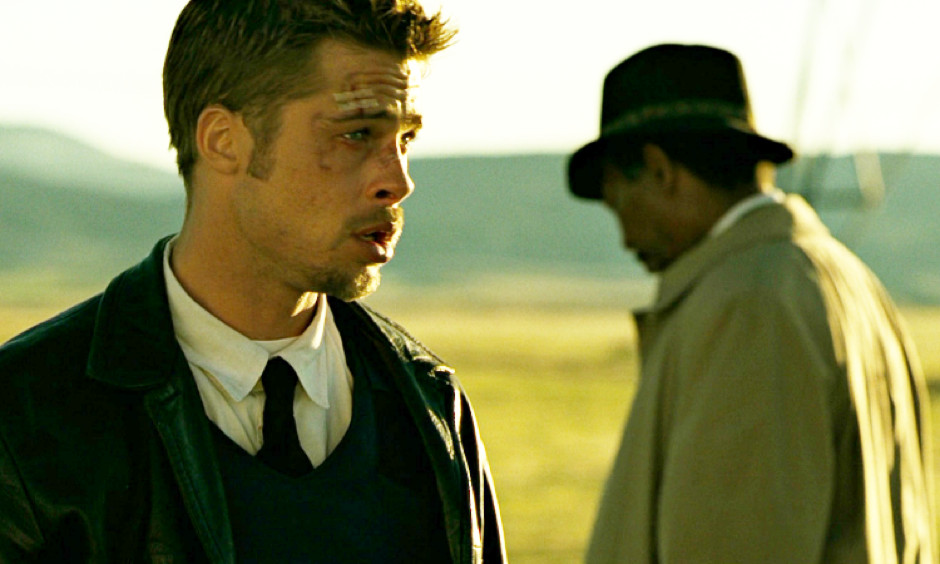
Fast forward to right where we stopped in the introductory paragraphs: when the three men drive to an undisclosed location in a desert. While on their way, Mills and Doe get into an argument wherein Doe asserts that his doing was, in a sense, holy, purging people or chastising the ones committing either of the seven cardinal sins, or literally the embodiment of those. Now there is actually no real way to know whether that in fact was his MO for killing all the people who he did; as det. Somerset states it, “doing god’s good work”, or whether, plainly put, he was just a raging lunatic with a possible psychosis (not that he wasn’t psychotic enough even if the former was his MO), in which case, he was just misdirecting the two detectives until they reached a very undesirable conclusion, very well understanding the nature of his crimes. David Mills retorts saying that he was no messiah, and his god complex, as has been the nature of a lot of serial killers on film, was just a front for covering the scum that he was.
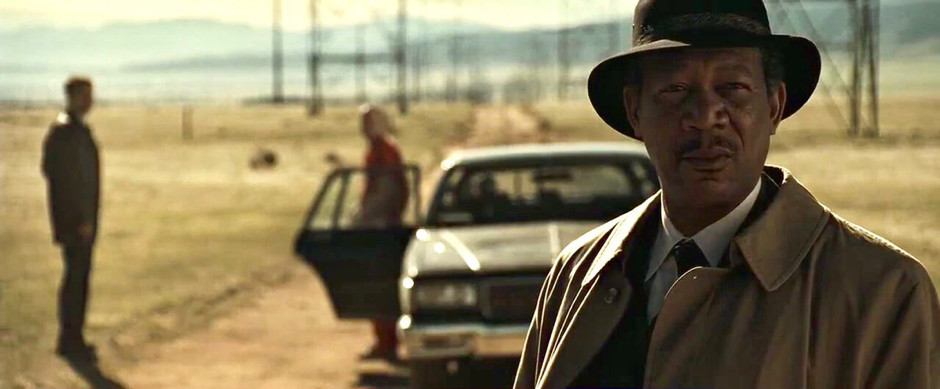
The trio then pull up near two high tension towers, where Doe is held at gunpoint as det. Somerset intercepts an approaching van. The van driver hands over a package meant for David Mills to Somerset, and he lets the driver go after suitably examining him. He sets the box down, glances over at the contents with caution and jumps back in horror. Immediately, he asks the accompanying reinforcements to stand down, exclaiming that “John Doe had the upper hand”, and starts running toward Mills, prompting him to drop his gun from afar.
At this point, Doe starts talking and reveals that earlier last morning, he went over to his house and “tried to play husband” with his beautiful wife Tracy. He taunts him over the kind of “perfectly normal life” that he had, and considers himself guilty of being envious of it, thus embodying the sin himself. In some gruesome details, he confesses to killing Tracy and that it was indeed her head in the box. Detective Mills is visibly devastated and broken, while Doe continues taunting him, prompting Mills to shoot him and “become vengeance, become Wrath”, even as Somerset advises to keep the gun down and not doing “exactly what Doe wanted”, which would make him win. It is not until Doe reveals that she begged for her life and for the life of the baby inside her, a fact that was until now, unknown to Mills, that he finally tips over and shoots him six times, as Somerset laments in the background, thus becoming the embodiment of the seventh and final sin, Wrath.
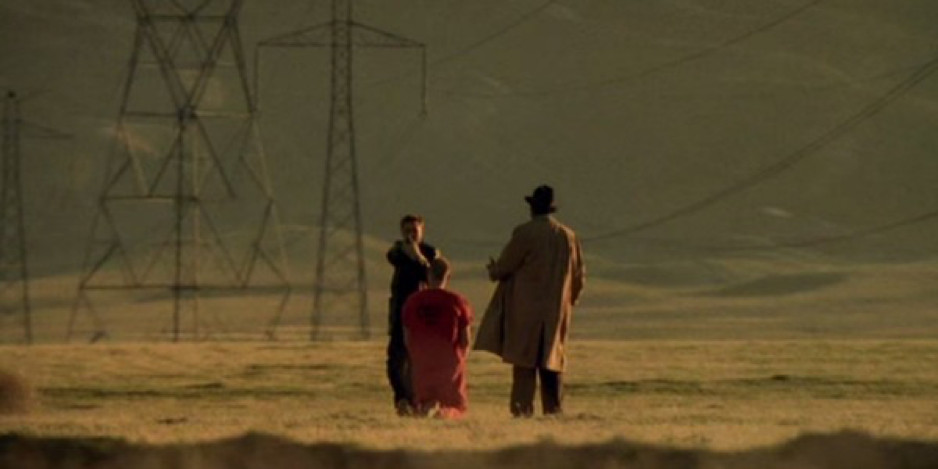
Now clearing up what has been discussed a lot regarding the film, the killer, the murders, their modus operandi and the victims, sin by sin. The killer, Jon Doe, didn’t necessarily wish to punish or chastise or make an example out of the people that were guilty of committing the one sin representative of the way in which they were murdered. Plus, I am pretty sure every human is guilty of committing at least one of those on a daily basis, so there’s that. Think of it as a serial killer going on a spree of killing one person each day, every murder and every move calculated, foreseen and meticulously planned, including his own death. What links the murders, apart from the killer himself, obviously, would be the way in which the murders are executed, each signifying or replicating a sin, and not necessarily punishing a particular person for a particular sin.
The seven sins are then the motifs, and not motives for the murders, or as Somerset puts it, “forced attrition”. While I am sure that John Doe wanted to make a point with his twisted methods, I am pretty sure it was not “doing god’s good work”, however he may have put it for himself in his head. This will be clearer when you read up on the following breakup of the murders.
The Seven Sins
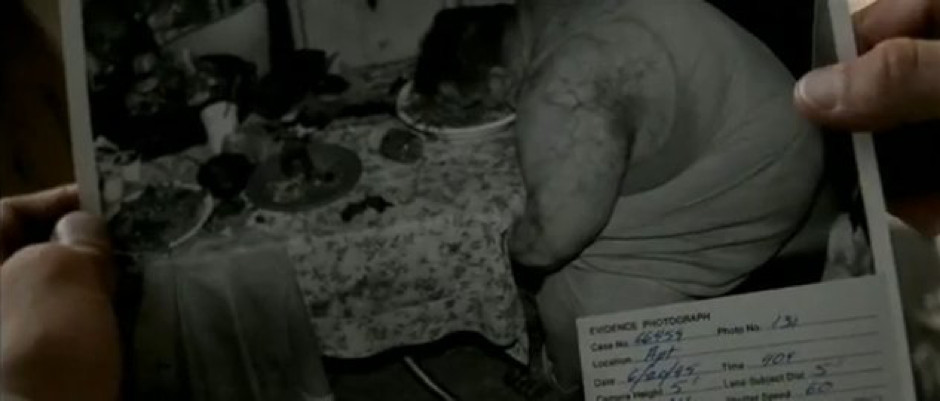
Gluttony; the first sin that conspires, the act of over indulging in food and drink and any sort of external material wealth even, and in the process withholding it from those who actually might need it. At least that’s what the Biblical definition says. However, in the film’s context, gluttony here, as an act of overindulging in only consumables was considered by the killer. The victim is an overweight, oversized man, seemingly chosen at random by the killer, and force-fed at gunpoint till the lining of his stomach and duodenum ruptured, in a cruel sense meaning that he literally died from eating too much, or as the killer saw it, was punished and chastised for gluttony, dying in the thick of it: committing the very sin.
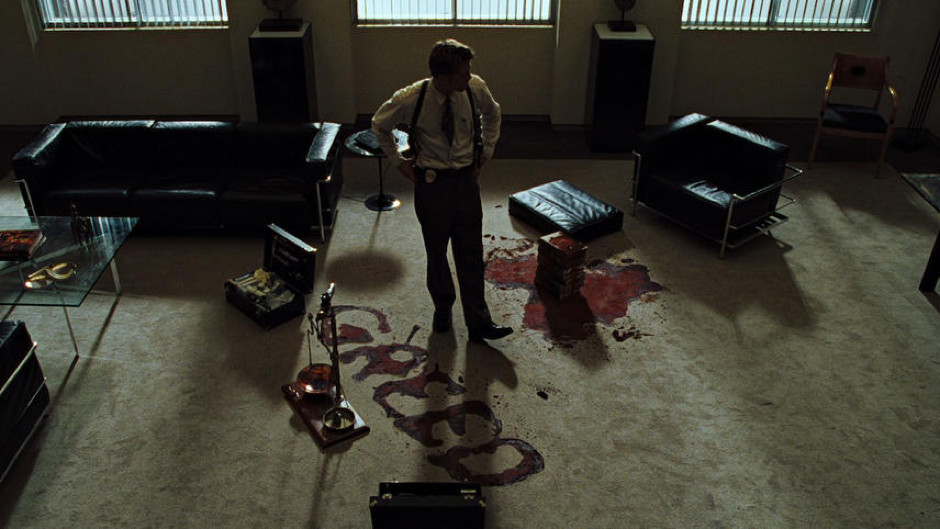
Greed; the second sin, wherein a defence attorney is murdered for indulging in greed for material wealth. It is here that the previously obscured MO of the killer becomes abundantly clear since after the victim is killed following the killer taking a pound of flesh from him, and the victim bleeds to death, Doe paints “greed” on the floor, in the victim’s blood. The same is done in the first scene too, but that is discovered later by Somerset. There is a Shakespearean reference in here too, a nod to one of his most popular works ‘The Merchant of Venice’, for those of you who might be looking. In this case too, the victim is also the perpetrator of the sin.
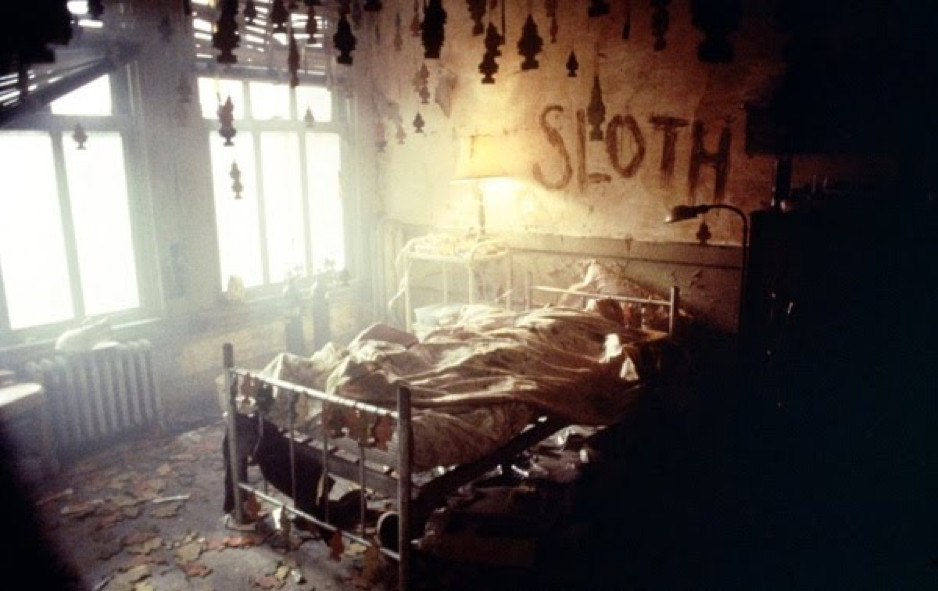
Sloth, the third sin, is executed in the most planned manner of them all, and is also the most long-term in its approach. Although, the sins here are only used as a motif and not a motive. Although the victim is a terrible person charged with multiple counts of armed robberies and even rape, the perpetration of the sin was forced upon him by John Doe: by tying him up to his bed and only keeping him barely alive, until at the end of one year, he assumes him to be dead due to immobility and inactivity in the brain. It is also revealed that since the victim was starved, he even chewed off his own tongue, and pictures of the victim taken over a course of one year, as he becomes increasingly frail and emaciated are kept aside for the investigation team to view, almost as if a taunt.
The victim, miraculously enough, turns out to be alive and is given immediate medical attention. Interestingly enough, he is also represented in the rape case against him by Eli Gould, victim of the greed crime. Although his brain function is almost completely gone and he is seriously weak, the third case presents just one of many loop holes, if I am to call them, in John Doe’s perpetration of his theory or MO.
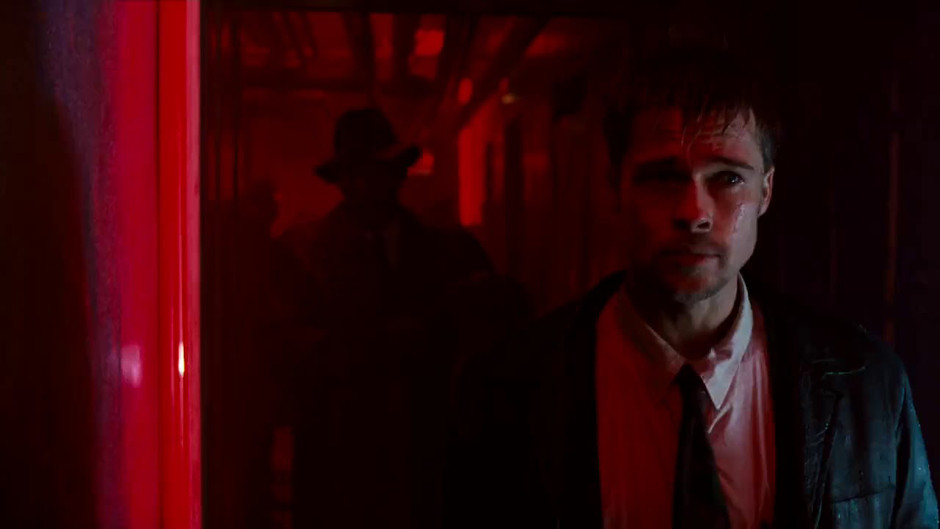
Lust; the fourth sin, unfolds in outright horrific fashion. Even after the detectives come close to catching the killer at his apartment, they discover his psychotic condition by looking at the photographs and notebooks in his apartment, and discover clues to the next one, wherein a prostitute is gruesomely murdered by a man who is forced to penetrate her with a bladed strap on. Her sin: inciting lust in others and embodying that lust herself. If I am to consider this a standard murder in the series of murders committed, it would be in the sense that as the first two, here too the victim was the sinner, albeit not related.
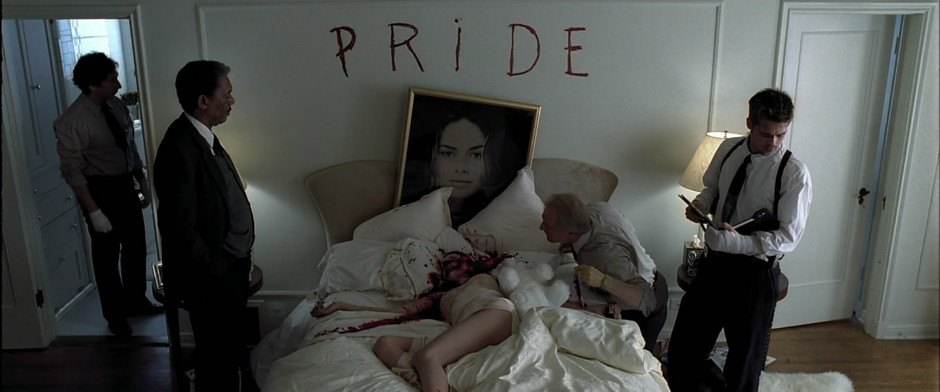
Pride; the fifth sin, is executed in a most joker-ish manner. How this is different from the four that have already conspired is that the victim is given a tough choice, and she fully embodies the sin and its consequences only by making one of them, while she may or may not have fully or partly embodied that sin during her life. The victim, a model, has her face mutilated by Joe, and is given the choice to call for help and live with her disfigurement, or to end her life with pills. The model chooses the latter, and in doing so, embodies pride in a way that places it above her own life.
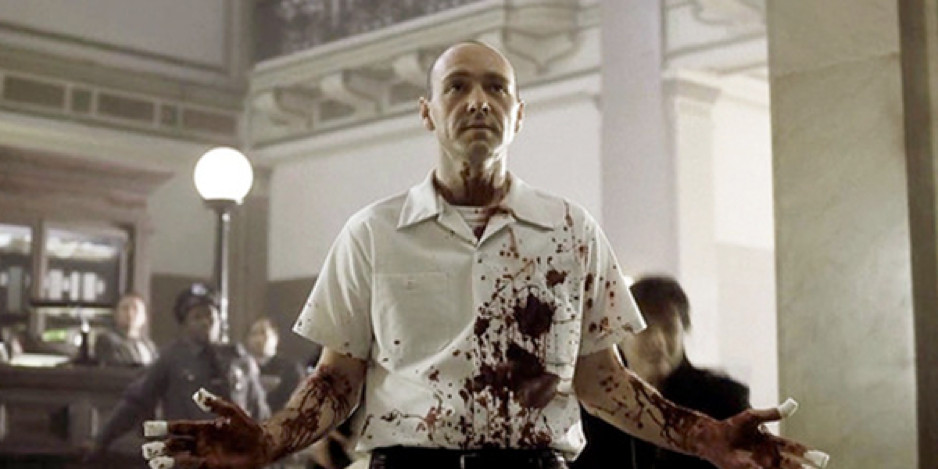
Envy; the sixth sin, is embodied by John Doe himself as revealed by him in the final bits of the film, one that he is suitably chastised for when he is killed by Mills, who embodies the final sin. Even though chronologically, it is Tracy that is killed, she cannot be considered a victim of the sin crimes. She was an instrument in reaching a calculated conclusion, one that John Doe had been staging for quite some time, although presumably, Mills came into the ploy only when he gave John Doe chase upon discovering his apartment. Thus, in a sense, it is the second to the last sin to be committed, and the last one to be chastised. However, the atypicality of this one that lends it differently from other sin crimes also furthers the hypothesis from the previous section that the murders weren’t necessarily committed as acts of god or to punish people for their sins. The gruesome murder of Tracy proves that.
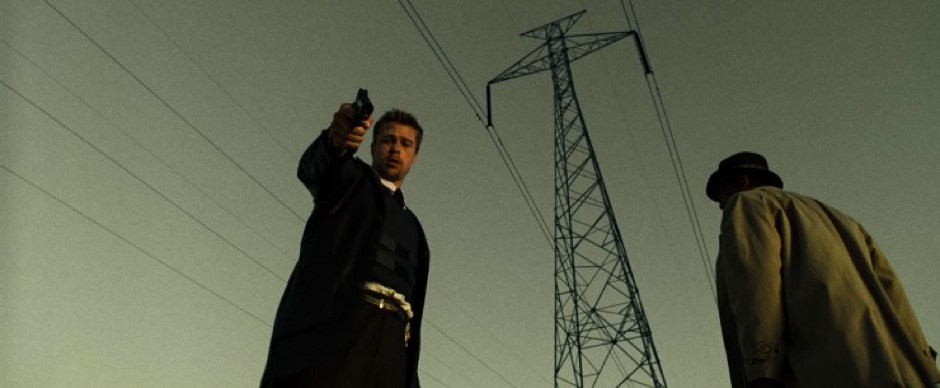
Wrath; the final sin of which, Detective Mills is an embodiment of conspires just as planned by the diabolical John Doe. In an attempt at retaliation or in a fit of rage, Mills tips over and pumps Doe full of bullets when he learns that Tracy had been killed by Doe mercilessly, and upon being unassumingly drawn into Doe’s sick game. The only sin, wherein the murder is not committed by Doe himself, but by Mills who actually turns out to be the victim here, rather than Doe who I have already discounted in the previous section. Mills, although not as a direct result of his embodiment of the final sin is now doomed to lead a life with no partner, and devastated upon knowing the news of his unborn child’s death too. That coupled with him obviously not being able to retain the detective post in the police force in the future of the film, is far worse a fate than most of them met.
Significance
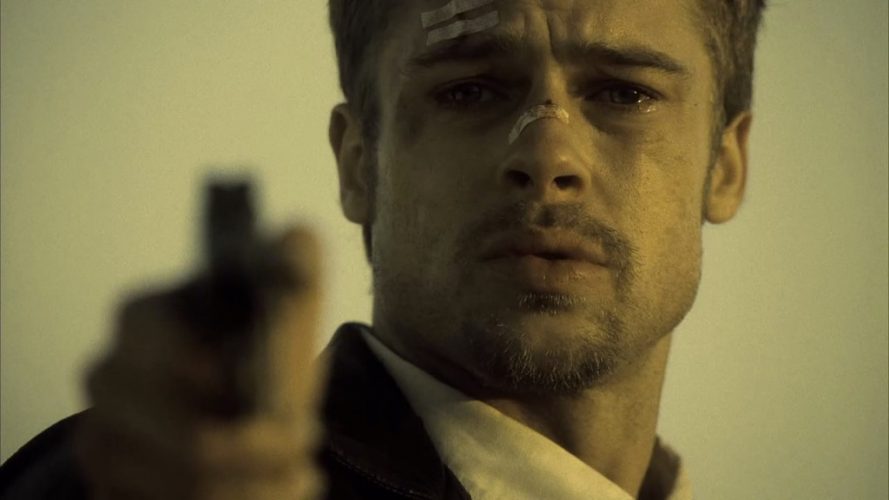
Well, we are all looking for something futile if we are looking to find the significance of the horrific murders depicted in the film. Truth is, there is no real significance of the murders in the film, nor in the motif, the way they are committed or the victims, none at all. There is no message to take home, nor a psychological insight that closes things out. The only thing we know is that this is entirely a lose-lose situation, with the bad guy winning in every possible outcome. It’s the rare kind of nihilistic ending that casts a dark shadow on everything with not even a faint glimmer, since you see virtually no way or solution that the good guys come out the other end unbroken.
In my opinion, the point the film brushes by in its final bits is neither about the bad guy winning, nor about him being proved right or anything like the good guys succumbing, but about the dubiousness of actions in general and the frailty of moral ground and compass. Question yourself on this: Has Mills become the bad guy now that he has committed a sin and a murder, even if in retaliation? The answer will indubitably be no, and that is not because you have grown to care for the character. It’s because it just feels right, right? Even if he had taken the moral high ground and not shot Doe and turned him in, little about his now miserable life would change. We timely question our moral ground, but when a situation as impossible as this one arrives, it all gets blown to hell, and to the bystander, even THAT would seem morally correct. In closing, Somerset cites the Ernest Hemingway quote, “The world is a fine place and worth fighting for”, stating that he agrees with the second part and that he would be “around” if the force needed anything from him, rededicating himself even if in a smaller capacity. That, ladies and gentlemen, is the bleak and stark beauty of this film. Se7en.
Read More in Explainers: Fight Club | Gone Girl | Mindhunter

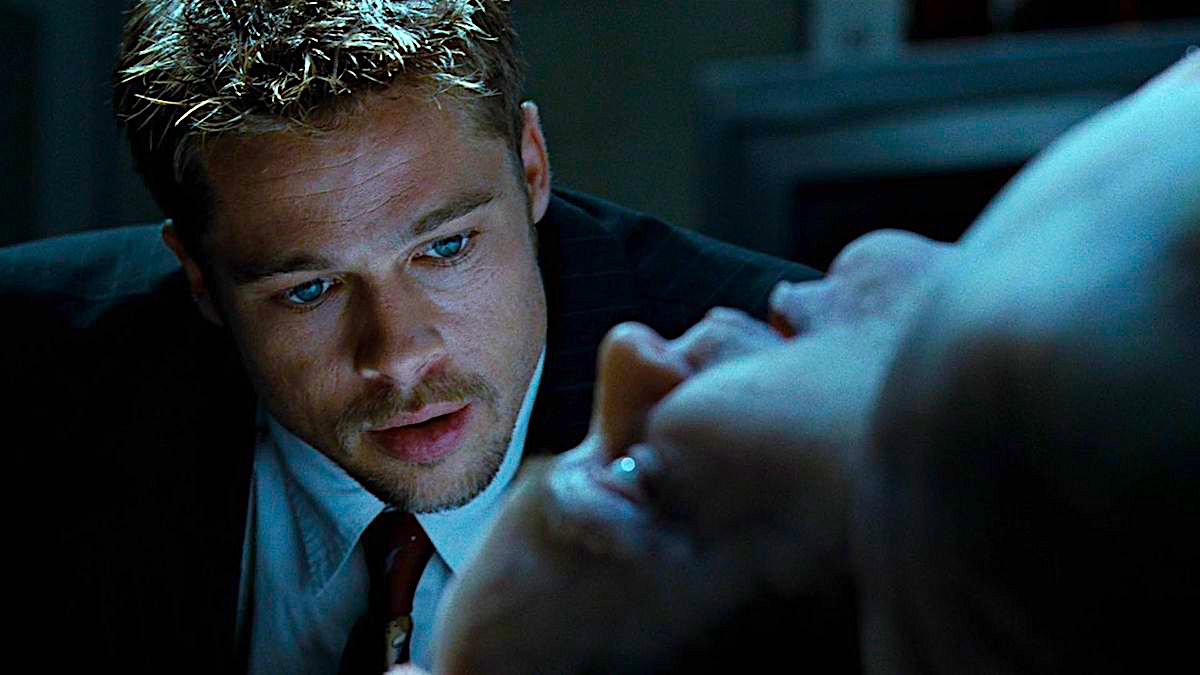
You must be logged in to post a comment.